Drones have been showing up on our radar more and more, including on the pages of IPWatchdog. We recently profiled recent UAS innovations as well as issues of hampered technological development because of regulatory uncertainty. Drones also took at least part of the stage at the recent 2015 Consumer Electronics Show, especially some products providing 4K image capture and other intriguing camera upgrades. There is little doubt that we will see more innovation in this space even as the government rushes to modify laws and regulations to address the growth in popularity in the drone marketplace.
With an eye toward taking a step forward on the regulatory front, on Sunday, February 15th, the U.S. Federal Aviation Industry released a proposed framework of regulations for unmanned aircraft systems (UAS), or drones, that the agency and many drone operators are hopeful will lead to the greater incorporation of drones into American airspace. However, some of the proposed regulations would effectively squash certain commercial applications of drone aircraft being developed by Amazon and others, or at least postpone them for the time being.
According to the agency, the rules are an attempt to juggle air traffic safety concerns while leaving private entities free to pursue some innovation in the field. “We want to maintain today’s outstanding level of aviation safety without placing an undue regulatory burden on an emerging industry,” said FAA Administrator Michael Huerta. Public comments on the proposed regulations can be submitted up until April 24th.
The proposed rules are designed to improve safety standards for the operation of unmanned aircraft weighing less than 55 pounds. Importantly, the rules establish standards for the registration of drone operators separate from those required of commercial aircraft, eliminating the possibility that drone operators would need to obtain a commercial pilot license to legally operate their aircraft. Under the proposed rules, drone operators must be at least 17 years of age, pass an aeronautical knowledge test and obtain a UAS license from the FAA.
Other parts of the proposed regulations are more restrictive. These most recent rules continue the line-of-sight requirement which maintains that a drone operator must keep the drone within their range of vision during operation. The rules also disallow small drones from flying over people, severely limiting their applications in urban areas. Flight restrictions include a maximum altitude of 500 feet and a maximum speed of 100 miles per hour.
These regulations are stringent enough to discourage certain commercial applications but the delivery of retail products, which is a goal of the Prime Air program being developed by Amazon, is entirely prohibited. The rules as they currently stand restrict drones from dropping any objects they may be carrying. Drone delivery of online purchases has been suggested by Amazon since December 2013 and by some measures the practice could save Amazon $2 per product shipped. In 2013, the company spent about $6.63 billion on product shipping.
Balancing Safety and Commercial Enterprise with Drones
As any new technology proliferates through the various strata of our society, there will be concerns regarding public safety. Major concerns regarding drones include the fear that an operator could lose control of their aircraft, turning a flying drone into a brick falling out of the sky. Privacy concerns also abound, especially as many of the drones sold commercial come with camera equipment for shooting video or capturing still images.
Without regulations in place from the FAA on drone operation, these concerns have prompted some interesting political responses to the ever-increasing presence of drones in our skies. The Senate Judiciary Committee for the state of Oklahoma, for example, just approved a bill to move along in the state legislature which would make it legal for a property owner to shoot a drone out of the sky if while passing over that person’s property. Of course, it’s still a federal crime to shoot any aircraft, but this kind of backlash would make it practically impossible to carry out retail delivery systems like Amazon Prime Air.
Projects like Amazon’s would require the use of sense-and-avoid technology for beyond-line-of-sight operating of an unmanned aerial system. Sense-and-avoid would enable drones to detect obstacles like trees, power cables and even other aircraft to prevent the disastrous consequences of a mid-air collision. Similar technologies have been supporting the rise of self-driving vehicles, another area of innovation that we’ve been following here on IPWatchdog. According to coverage by Politico, the FAA will continue to evaluate the growth of sense-and-avoid technologies to determine whether certain commercial applications for drones can be pursued.
The FAA has allowed certain drone operations to take place that go outside of the proposed restrictions, although this has been on a strict case-by-case basis. Kansas State University at Salina, for example, was granted the right to operate drones at heights up to 700 feet, 200 feet beyond the proposed regulations, to aid in research of drought stress and bug infestations. The university can operate these drones on its property or on private property, if the owner allows it, but the drone operator still has to keep the drone within his or her line of vision.
Public/Private Response to Regulations and Enforcing the Rules
Obviously, companies who have invested thousands and perhaps even millions of dollars into drone programs for business purposes are not entirely happy with the proposed rules. Corporate lobbying of the FAA is expected to be very well funded. Money spent on lobbying activities regarding drones has already experienced exponential growth. In 2001, spending on special interest lobbying for drones was $20,000, according to statistics reported by the Center for Responsive Politics. By the time drones became commercially marketable, that spending rose to $35 million in 2011. In 2014, drone lobbyists spent $186 million.
Drone hobbyists and most individual operators, however, seem to be in favor of the rules which have been proposed. There are many who are encouraged that the FAA has cleared up the requirements for licensing and registering drone operators and the guidelines are less stringent than the process to obtain a commercial pilot’s license, which some had feared would be the case. As for operating drones away from crowds and within the operator’s line-of-sight, there are many who use a UAS for real estate photography and crop inspections who already respect those safety practices in their work.
If the FAA gets their way, the brunt of enforcing the rules that the agency eventually puts in place will become the work of local police agencies across the country. About a week after releasing the proposed drone regulations, FAA official Mark Bury met with a large group of state attorneys general to enlist the help of local law enforcement in enforcing FAA rules on drones. Local police would also be responsible for charging citizens who do shoot UAS aircraft out of the sky, which could create an interesting situation in Oklahoma if that state manages to pass its drone shoot-down bill.
Recent Patented Innovations in Unmanned Aerial Vehicles
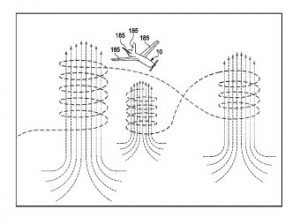 With the proposed FAA drone regulations being published, we thought that our readers might be interested to learn about new patents for UAS technologies being patented in recent weeks. Early in February, the Boeing Company was issued U.S. Patent No. 8954206, simply titled Unmanned Aerial Vehicle, to protect a newly designed drone that can harvest energy from updrafts for staying aloft. The patent claims a method of an unmanned aerial vehicle (UAV) configured to glide within a geographic region by defining a maximum altitude threshold for the region, identifying the location of an updraft within the region, maneuvering the UAV within the identified updraft and harvesting energy from the motion of a UAV through regenerative braking of the rotor. This technology is very relevant to drone operation in America as it seeks to take the fullest advantage of updraft energy for drone movement when drones are prohibited from flying at certain heights, which inhibits their ability to utilize the entire updraft.
With the proposed FAA drone regulations being published, we thought that our readers might be interested to learn about new patents for UAS technologies being patented in recent weeks. Early in February, the Boeing Company was issued U.S. Patent No. 8954206, simply titled Unmanned Aerial Vehicle, to protect a newly designed drone that can harvest energy from updrafts for staying aloft. The patent claims a method of an unmanned aerial vehicle (UAV) configured to glide within a geographic region by defining a maximum altitude threshold for the region, identifying the location of an updraft within the region, maneuvering the UAV within the identified updraft and harvesting energy from the motion of a UAV through regenerative braking of the rotor. This technology is very relevant to drone operation in America as it seeks to take the fullest advantage of updraft energy for drone movement when drones are prohibited from flying at certain heights, which inhibits their ability to utilize the entire updraft.
The testing of drones for a variety of commercial and industrial purposes to reduce the size and cost of the manufactured drone is disclosed and protected by U.S. Patent No. 8942964, entitled Optical State Estimation and Simulation Environment for Unmanned Aerial Vehicles. Issued in late January to the Southwest Research Institute of San Antonio, TX, the patent protects a method for simulating a UAV in a simulated environment by receiving a first simulated view from a graphical simulator which simulates a visual sensor located on the UAV, estimating pitch, roll and ground speed of the simulated UAV, determining a position and orientation of the simulated UAV based on those flight characteristics and repeating this process with a second generated simulated view. This system would enable an enhanced process of designing a drone with only those sensors necessary for certain jobs, such as flying within a building or flying within a formation.
The use of UAVs to aid in medical emergency situations is described by a pair of patents that we came across today. The delivery of medical support devices has been protected for Google through the issue of U.S. Patent No. 8948935, which is titled Providing a Medical Support Device Via an Unmanned Aerial Vehicle. The UAV claimed here includes a housing configured to hold a medical support device, a winch system serving as a delivery mechanism and a control system that receives a request for medical assistance at an individual medical situation, determining the target location, navigating the UAV to the target location, transitioning the UAV to a hover flight mode once the location has been reached and lowering the medical support device to the ground with the winch system. This technology would enable a drone to deliver a first aid kit, defibrillator or other medical devices in response to a reported medical emergency. The delivery of medical treatments to individuals who need them is at the center of U.S. Patent No. 8909391, which is titled Responsive Navigation of an Unmanned Aerial Vehicle to a Remedial Facility. The deployment system protected by this patent includes a communication system that receives diagnostic data regarding an object having an expiring condition which is held by a UAV and a logic module that determines that the expiration condition has been satisfied; once satisfied, the UAV is sent instructions to navigate to a remedial facility. This system is capable of determining that a medication has expired prior to delivery and enabling a system of replenishing the expired medication with a fresh one at a remedial facility. This is another Google patent, issued to the company at the beginning of December.
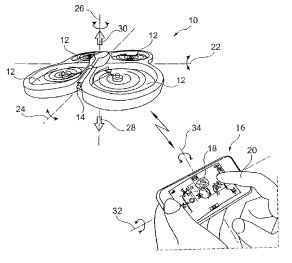 The control of UAVs directly from a mobile phone is a technology protected by Parrot of Paris, France, through the issue of U.S. Patent No. 8958928, titled Method and an Appliance for Remotely Controlling a Drone, in Particular a Rotary Wing Drone. The method for implementing a remote-control appliance for a drone claimed here involves an appliance with a touchscreen and a wireless data transmission device for detecting a finger contact on the screen, displaying a movable piloting icon that tracks finger movement, detecting the movement of that icon, analyzing a direction, amplitude or speed relative to the finger movement and activating a piloting command based on the finger motion. With this system, a user could use an iPhone or a similar touchscreen device to move a drone forward, backward, left or right of its current position.
The control of UAVs directly from a mobile phone is a technology protected by Parrot of Paris, France, through the issue of U.S. Patent No. 8958928, titled Method and an Appliance for Remotely Controlling a Drone, in Particular a Rotary Wing Drone. The method for implementing a remote-control appliance for a drone claimed here involves an appliance with a touchscreen and a wireless data transmission device for detecting a finger contact on the screen, displaying a movable piloting icon that tracks finger movement, detecting the movement of that icon, analyzing a direction, amplitude or speed relative to the finger movement and activating a piloting command based on the finger motion. With this system, a user could use an iPhone or a similar touchscreen device to move a drone forward, backward, left or right of its current position.
Finally, we were able to find an invention developed to address the need for sense-and-avoid technology for drone aircraft, which is evidenced within U.S. Patent No. 8963997, titled Laser Scanner Device and Method for Three-Dimensional Contactless Recording of the Surrounding Area By Means of a Laser Scanner Device. The patent, issued to the German Aerospace Center of Cologne, Germany, claims a laser scanner device with a laser beam emission apparatus, an emission area with a mirror, a receiving apparatus for receiving reflections of the laser beam, multiple drive devices which each move separate kinematic chains connected to the mirror for deviating the mirror direction. The simple and lightweight laser system of this invention is capable of quicker scanning times, which is advantageous for sense-and-avoid technology supporting safe flight.

![[IPWatchdog Logo]](https://ipwatchdog.com/wp-content/themes/IPWatchdog%20-%202023/assets/images/temp/logo-small@2x.png)

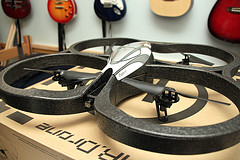
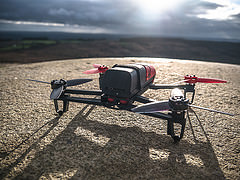
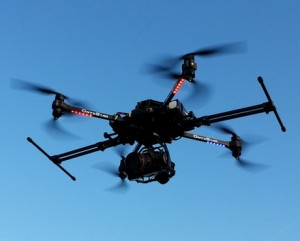
![[Advertisement]](https://ipwatchdog.com/wp-content/uploads/2024/04/Patent-Litigation-Masters-2024-sidebar-early-bird-ends-Apr-21-last-chance-700x500-1.jpg)

![[Advertisement]](https://ipwatchdog.com/wp-content/uploads/2021/12/WEBINAR-336-x-280-px.png)
![[Advertisement]](https://ipwatchdog.com/wp-content/uploads/2021/12/2021-Patent-Practice-on-Demand-recorded-Feb-2021-336-x-280.jpg)
![[Advertisement]](https://ipwatchdog.com/wp-content/uploads/2021/12/Ad-4-The-Invent-Patent-System™.png)







Join the Discussion
No comments yet.